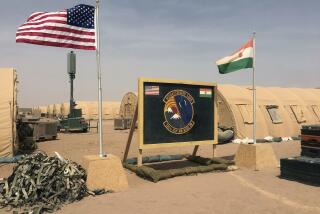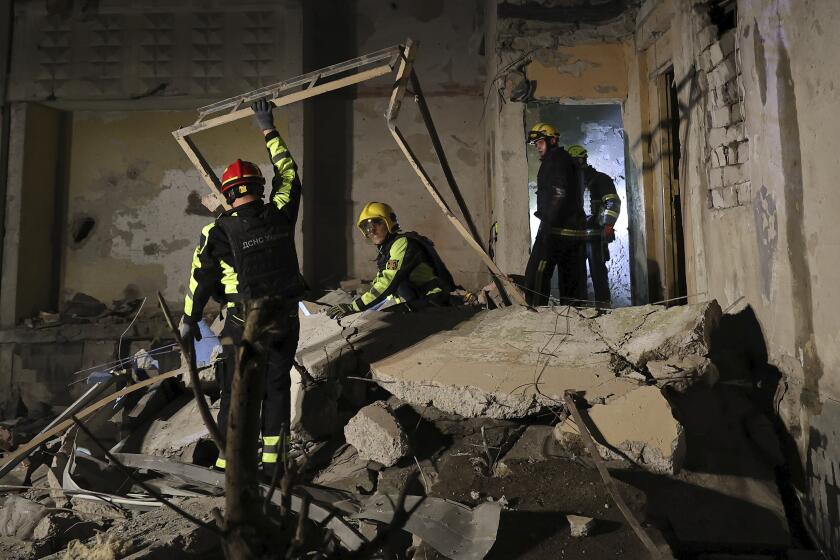U.S.-backed rebels launched their first attack against Islamic State. They lost.
The United States trained the rebel New Syrian Army in hopes that it would be a formidable opponent to Islamic State jihadists.
But in its first serious test — an offensive near the Syrian border town of Bukamal — the rebels appear to have failed.
Islamic State took much of the oil-rich desert region straddling the border between Iraq and Syria in 2014.
On Tuesday, the New Syrian Army announced an operation to wrest control of territory near Bukamal. The group said on its Facebook page that the campaign was launched in conjunction with Iraqi pro-government forces storming the Iraqi town of Qaim just across the border.
The two towns are a crucial link in Islamic State’s self-proclaimed caliphate.
The next day, Aamaq, a news agency affiliated with Islamic State, said the jihadists had killed 40 members of the New Syrian Army and captured 15 in a counterattack on the defunct Hamdan air base northwest of Bukamal.
See the most-read stories in World News this hour >>
Video posted by the news agency showed jubilant Islamic State fighters parading in trucks sporting the New Syrian Army’s insignia and fawning over heavy weapons and ammunition belts apparently captured in the fighting.
One militant is shown mutilating the corpse of a rebel fighter and cutting off the head.
The New Syrian Army withdrew from the area, marking the latest setback for U.S. plans to train and equip Syrian rebels capable of battling Islamic State militants.
Previous iterations of the program were widely ridiculed for producing minuscule numbers of capable fighters who were easily overwhelmed by Islamist factions wary of U.S. intervention.
Many rebels were also reluctant to enroll in any U.S. effort, because of a stringent vetting process meant to detect any Islamist sympathies and because of U.S. insistence that trained fighters concentrate on attacking only Islamic State.
The New Syrian Army, however, had promised to be different.
It first appeared in November 2015 with the stated goal of pushing Islamic State out of the eastern Syrian desert. Since then, its fighters have shown up in slickly produced videos uploaded to social media that depict uniformed men training with U.S. weapons.
Analysts say the group – which is headquartered near Tanf, a southern town close to where the borders of Jordan, Iraq and Syria converge – has also received support from Jordanian special forces units.
Wednesday’s defeat, however, may have cost the group a full fifth of its cadres.
Rami Abdul Rahman, head of the pro-opposition monitoring group Syrian Observatory for Human Rights, estimated that the rebel group had comprised about 125 fighters, but that after Islamic State’s counteroffensive “they are probably less than a hundred.”
“They did nothing,” he said. “They went to the border and came back. This was more a media show than anything else.”
The New Syrian Army tried to put the best possible spin on the defeat.
On Wednesday, the group alleged that it had killed 20 Islamic State fighters and wrested control of the border crossing as well as territory in the southern and eastern approaches to Bukamal, and that it had set up a radio station in the area to “give directions and warnings to residents.”
A spokesman for the group, Mozahem Saloum, said in an interview on social media that helicopters had deployed additional rebels “behind enemy lines” near the air base — a claim that was confirmed by the observatory group but denied by Pentagon officials.
Join the conversation on Facebook >>
Although Saloum acknowledged that the rebel fighters had later withdrawn from the area after heavy resistance by Islamic State, he insisted it was a tactical retreat that had marked the end of what he described as a “deep penetration raid.”
He said that only three of the group’s fighters were killed and that the group still controlled desert areas near Bukamal and maintained “the freedom of military maneuverability.”
Meanwhile, coalition warplanes conducted eight airstrikes that wiped out bridges, a training camp and militant fighting positions, according to the Pentagon. Five additional strikes in Qaim hit two weapons caches and communications facilities.
“We are looking to inflict damage on Daesh in that location inside Syria,” said Col. Christopher Garver, a spokesman for the U.S.-led coalition in Baghdad. “Daesh” is the Arabic acronym for Islamic State.
“Cutting these supply lines will impact the flow of foreign fighters and supplies between the upper and lower Euphrates Valley,” Garver said.
Bulos is a special correspondent. Staff writer W.J. Hennigan in Washington contributed to this report.
MORE WORLD NEWS
Hanging of dog on Taiwan military base stirs outrage, reform pledges
Turkey’s tourism and recreation industry struggles after months of terror attacks
How the attack on Turkey’s Ataturk Airport unfolded
More to Read
Sign up for Essential California
The most important California stories and recommendations in your inbox every morning.
You may occasionally receive promotional content from the Los Angeles Times.









